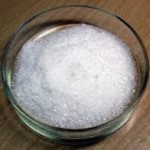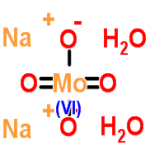CAS Number 10102-40-6, Sodium Molybdate Dihydrate BP Ph Eur Grade Manufacturers Exporters







CAS Number 10102-40-6, Sodium Molybdate Dihydrate Manufacturer Exporter
For Properties Specifications of Sodium Molybdate Dihydrate Click Properties, Specifications of Sodium Molybdate Dihydrate Manufacturer.
For Uses of Sodium Molybdate Dihydrate Click Uses of Sodium Molybdate Dihydrate Manufacturer.
For For SDS MSDS Sheet of Sodium Molybdate Dihydrate Click SDS Safety Data Sheet MSDS Sheet of Sodium Molybdate Dihydrate Manufacturer.
The Properties and Specifications of Sodium Molybdate Dihydrate:
Sodium Molybdate Dihydrate BP Ph Eur Grade Specifications
Ph Eur
Na2MoO4,2H2O -- 241.9 -- CAS 10102-40-6
DEFINITION
Content: 98.0 per cent to 100.5 per cent (dried substance).
CHARACTERS
Appearance: White or almost white powder or colourless crystals.
Solubility: Freely soluble in water.
IDENTIFICATION
A. Loss on drying (see Tests).
B. Dissolve 0.2 g in 5 ml of a mixture of equal volumes of nitric acid and water and add 0.1 g of ammonium chloride. Add 0.3 ml of disodium hydrogen phosphate solution and heat slowly at 50-60C. A yellow precipitate is formed.
C. Dissolve 0.15 g in 2 ml of water, the solution gives reaction of sodium.
TESTS
Solution S: Dissolve 10.0 g in water and dilute to 50 ml with the same solvent.
Appearance of solution: Solution S is clear and colourless.
Chlorides: Maximum 50 ppm.
Phosphates: Maximum 200 ppm.
Ammonium: Maximum 10 ppm, determined on 0.10 g.
Heavy metals: Maximum 10 ppm.
Loss on drying: 14.0 per cent to 16.0 per cent, determined on 1.000 g by drying in an oven at 140C for 3 h.
The Uses of Sodium Molybdate Dihydrate:
Sodium Molybdate, Dihydrate is used in the manufacturing of inorganic and organic pigments, as a corrosion inhibitor, as a bath additive for finishing metals finishing, as a reagent for alkaloids, and as an essential micronutrient for plants and animals. In industrial water treatment applications, sodium molybdate offers the best corrosion protection in systems of bimetallic construction versus sodium nitrite.
The MSDS-SDS Hazard Statement of Sodium Molybdate Dihydrate:
Sodium Molybdate Dihydrate SDS, Safety Data Sheet
MSDS Sheet, Material Safety Data Sheet 25-Jan-23
Section 1: Chemical Product and Company Identification
Product Name & Other Names: Sodium molybdate Dihydrate or Molybdic acid sodium salt dihydrate.
CAS-No. : 10102-40-6
EINECS EC-Number: 231-551-7
Molecular Formula: Na2MoO4-2H2O
Molecular weight: 241.9
Relevant uses and uses advised against (if any): For laboratory and industrial use only.
Section 2: Hazards Identification
GHS, Globally Harmonized System Classification in accordance with 29 CFR 1910
Classification according to Regulation (EC) No 1272/2008:
Not a hazardous substance or mixture according to Regulation (EC) No. 1272/2008.
This substance is not classified as dangerous according to Directive 67/548/EEC.
Labeling according to GHS & Regulation (EC) No 1272/2008
GHS Label Elements NONE |
Signal Word: None
Precautionary statements:
P261: Avoid breathing dust/fume/gas/mist/vapors/spray.
P262: Do not get in eyes, on skin, or on clothing.
P281: Use personal protective equipment as required.
P302+P352: IF ON SKIN: Wash with plenty of soap and water.
P305 +P351+P338: IF IN EYES: Rinse cautiously with water for several minutes. Remove contact lenses, if present and easy to do. Continue rinsing.
Section 3: Composition and Information on Ingredients
Product Name & Other Names: Sodium molybdate Dihydrate or Molybdic acid sodium salt dihydrate.
CAS-No. : 10102-40-6
EINECS EC-Number: 231-551-7
Section 4: First Aid Measures
Always seek medical advice after the first aid treatment.
Skin: Wash off with soap and plenty of water.
Eyes: Wash eyes with plenty of water for at least 15 minutes, lifting lids occasionally. Seek Medical Aid.
Inhalation: Remove to fresh air. If not breathing, give artificial respiration. If breathing is difficult, give oxygen.
Ingestion: Never give anything by mouth to an unconscious person.
Section 5: Fire and Explosion Data
Flammability of the Product: Non-flammable.
Fire Fighting Media and Instructions: Use water spray, alcohol-resistant foam, dry chemical or carbon dioxide.
Special hazards arising from the substance or mixture: Sodium oxides, Molybdenum oxides.
Special Information: In the event of a fire, wear full protective clothing and NIOSH-approved self-contained breathing apparatus with full face piece operated in the pressure demand or other positive pressure mode. At high temperatures under fire conditions, it may produce toxic or irritating fumes. Fire-extinguishing work is done from the windward and the suitable fire-extinguishing method according to the surrounding situation is used.
Section 6: Accidental Release Measures
Personal precautions, protective equipment, and emergency procedures: Avoid breathing dust/fumes/gas/mist/vapors/spray. Use individual protective equipment (waterproof boots, suitable protective clothing, safety glasses, etc.). Do not approach facing the wind.
Environmental precautions: Do not let the product enter drains, soil, or water sources.
Methods and materials used for containment Cleanup procedures and Storage: Do not inhale dust, vapors, mist, or gas. Avoid dust formation. Contain spilled material. Cover with an inert, non-combustible absorbent material, (e.g. sand, earth, diatomaceous earth, vermiculite). Use a shovel to put the material into a convenient waste disposal container. Finish cleaning by spreading water on the contaminated surface and allow to evacuate as per law.
Section 7: Handling and Storage
Precautions for safe handling: Apply according to good manufacturing and industrial hygiene practices. Ensure proper ventilation. In case of insufficient ventilation, wear suitable respiratory equipment. Wash thoroughly after handling. Do not drink, eat, or smoke while handling. Avoid contact with skin, eyes, and clothing. Minimize dust generation. Avoid breathing dust/fumes/gas/mist/vapors/spray. Keep container tightly closed. Avoid ingestion and inhalation. Use individual protective equipment (waterproof boots, suitable protective clothing, safety glasses, etc.).
Conditions for safe storage, including any incompatibilities: Store in cool, dry, and ventilated area away from heat sources and protected from sunlight in tightly closed original container. Keep air contact to a minimum. Store protected from heat, sparks and ignition sources and incompatible materials. Avoid contact with skin and eyes. Avoid inhalation of dust/mist/vapor. Do not store with incompatible materials like strong oxidizing agents and acids.
Section 8: Exposure Controls/Personal Protection
Exposure Limits:
USA. OSHA. TWA 5 mg/m3
USA ACGIH (TLV) TWA: 0.5 mg/m3.
Engineering Controls: Use process enclosures, local exhaust ventilation, or other engineering controls to keep airborne levels below recommended exposure limits.
Ventilation System: A system of local and/or general exhaust is recommended to keep employee exposures as low as possible.
Personal Respirators (NIOSH Approved): For conditions of use where exposure to dust or mist is apparent and engineering controls are not feasible, a particulate respirator may be worn.
Skin Protection: Wear protective gloves and clean body-covering clothing.
Eye Protection: Use chemical safety goggles and/or full face shield where dusting or splashing of solutions is possible. Maintain eye wash fountain and quick-drench facilities in work area.
Other Control Measures: Maintain good housekeeping in work area. Handle in accordance with good industrial hygiene and safety practice.
Section 9: Physical and Chemical Properties
Physical state and appearance: Solid. White crystals.
Odor: Odorless.
Odor threshold: Not available.
pH: Not available.
Relative density: around 3.3
Melting point/freezing point: Not available.
Initial boiling point and boiling range: Not available.
Flash point: Not available.
Auto-ignition temperature: Not available.
Decomposition temperature: Not available.
Upper/lower flammability or explosive limits: Not available.
Vapor pressure: Not available.
Vapor density: Not available.
Evaporation rate: Not available.
Flammability (solid, gas): Not available.
Partition coefficient: n-octanol/water: Not available.
Solubility: Soluble in water.
Viscosity: Not available.
Section 10: Stability and Reactivity Data
Stability: Stable under the condition of storage.
Conditions of Instability: Incompatible materials
Incompatibility with various substances: Oxidizing agents.
Polymerization: Will not occur.
Section 11: Toxicological Information
Toxicity to Animals: LD50 Intraperitoneal - Rat - 520 mg/kg
Carcinogenicity: No component of this product present at levels greater than or equal to 0.1% is identified as possible or confirmed human carcinogen by IARC, ACGIH, OSHA and NTP.
Mutagenic Effects: Not available.
Developmental Toxicity: Not available.
Reproductive Effects: No information available.
Section 12: Ecological Information
Toxicity to fish: Not available.
Results of PBT and vPvB assessment: This substance/mixture contains no components considered to be either persistent, bioaccumulative and toxic (PBT), or very persistent and very bioaccumulative (vPvB) at levels of 0.1% or higher.
Section 13: Disposal Considerations
Waste Disposal: Waste must be disposed of in accordance with federal, state, and local environmental control regulations.
Section 14: Transport Information
DOT USA, TDG Canada & ADR/RID Europe: Not controlled.
IMDG/IMO: Not controlled.
IATA: Not controlled.
Section 15: Other Regulatory Information
USA:
SARA 311/312 Hazards: See sectin 2.
California Prop. 65 Components: Not listed.
Disclaimer:
*****************************
Our company provides this MSDS sheet in good faith but makes no representation as to its comprehensiveness or accuracy. This SDS sheet is intended only as a guide to the appropriate precautionary handling of the material by a properly trained person using this product. The above information has been compiled from various sources and has the possibility of discrepancy and being out-dated information. Individuals receiving the information must exercise their independent judgment and do further search in determining its appropriateness for a particular purpose. In no case shall our company be liable to loss or damages by the product user.
*****************************
Anmol Chemicals & Pharmaceuticals Pvt. Ltd. is an off-shoot of Anmol Chemicals Taloja. It is located in MIDC Taloja and it is manufacturing pharmaceutical grades of API, Excepients, Food grade and Reagent grade chemicals. Anmol Chemicals & Pharmaceuticals Pvt. Ltd. is a several decades old group of companies, engaged in manufacturing, supplying, distributing, wholesale supplies for actual users, retail or small pack supplies for research and development chemicals, fine and speciality chemicals, pharmaceutical excipients, mineral fortifiers in chemically pure, Analytical reagent grade, IP BP USP Ph Eur EP JP and other pharmaceutical grade monograph including FCC Food grade chemicals and Nutraceuticals, Mineral Fortifiers at best prices.

Sodium Molybdate Dihydrate Structure
CAS Number 10102-40-6, Sodium Molybdate Dihydrate Manufacturer Exporter
ANMOL CHEMICALS & PHARMACEUTICALS Pvt. Ltd.
India, USA, Europe, UAE
TELEPHONE: +912223770100
Navi Mumbai, INDIA
e-mail: info(At the rate i.e. @)anmol.org
Copyright. 25-nov-24
We manufacture:
Glacial Acetic Acid Manufacturer

